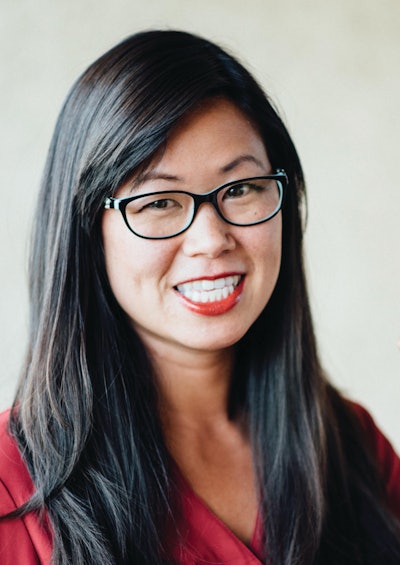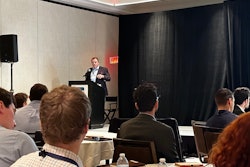Tell us about your background and how you got into the packaging industry.
When I interned on Wall Street at Merrill Lynch, I quickly realized that it wasn’t the right career path for me. Luckily, Procter & Gamble was recruiting on campus, and I entered the world of packaging, which I knew nothing about at the time. At P&G, I was asked to lead their global recycled and bio-based plastics sourcing strategy, and I fell in love with the field of sustainable packaging.
I eventually went to Starbucks, where I got to experience the fiber side of the packaging business, and Coca-Cola, where I led development of the World Without Waste sourcing strategy for closures, labels, and films. Most recently, I then spent two years on the converter side of the business to get a different perspective leading corporate sustainability for both healthcare and consumer products at Westfall-Technik before coming back to the brand owner side at Mars in 2021.
What is the most rewarding part of your job today?
I love knowing that what I’m doing is positively impacting the environment and being able to see our innovations on shelves or used by consumers.
It’s a great privilege to work at Mars, where it is investing hundreds of millions of dollars to reimagine and redesign more than 12,000 packaging across its diverse portfolio. Today, almost half of our packaging portfolio is undergoing redesign or elimination to be more sustainable.
To be part of such a progressive and ambitious sustainable packaging program at Mars, I feel both a tremendous amount of excitement and responsibility to deliver the results, especially knowing how much of a positive environmental impact it can bring to the world for us and future generations.
It’s also great to work for a company that does sustainability differently. Mars is holding itself accountable by embedding its packaging targets into how it measures overall business success. The company’s top 300 executives now have remuneration linked to delivering against the packaging targets.
It’s also just an amazing time right now to be working on packaging sustainability. Through the Consumer Goods Forum and the Business Coalition for a Plastics Treaty, we are able to directly engage in the UN Global Treaty to End Plastics Pollution process, which has the potential to drive monumental impact at scale and speed.
What are some of the challenges that you have faced as a woman in a male-dominated industry?
It’s not a secret that the packaging industry is still heavily male dominant. Similarity bias drives recruiting practices to keep the status quo, and companies and individuals need to make a purposeful, conscious effort to break that cycle. I've seen a lot of diverse talent join the packaging industry and then leave it because they did not feel welcomed and valued. It can be intimidating if no one you work with looks like you.
We need to focus on educating and promoting the work we do to the next generation of female talent, and then ensure that we’re creating an environment where diverse backgrounds are welcomed and valued, so that talent can be retained and represented at all levels.
What are the unique opportunities for women in this industry?
Addressing packaging waste is a global challenge that will require fresh and diverse perspectives, innovation and new systems-thinking to tackle. With my experience as an Asian American woman in the packaging industry, I am proud to bring my diverse background and perspective to drive progressive changes at Mars and help accelerate progress towards our Sustainable Packaging Plan.
I believe that underrepresented demographics in this industry, such as women, will play a pivotal role in accelerating the solutions needed to create a more sustainable future. And as with any consumer-facing business, companies will be more successful if their employee base represents their customer base. Darwin is often misquoted, it’s not survival of the fittest, it’s survival of the most adaptable, and diversity drives adaptability.
What can the industry do better to support women and increase the number of women in leadership positions?
Throughout my career, I had very robust sponsorship and mentorship programs, as well as specific development programs for Asian Americans and women. I’m extremely thankful for the early exposure to those development programs, as they helped me better understand and be better prepared for both the conscious and unconscious biases that I would face in the corporate world.
I believe in the “lift as you climb” principle. I had and still have great mentors and sponsors, and always seek to pay that forward. With more women entering the packaging and sustainability world now, I’m hoping to see more programs that support and encourage women to both join and remain in the industry, where they can hopefully both see representation at all levels and feel like they are working in an inclusive environment.
For example, at Mars, we have a program called Full Potential that aims to advance gender equality in our workplaces, in the marketplace, and in communities where we source raw materials. In our workplaces, we are taking action with policies and practices to improve representation and associate benefits while ensuring we continue to pay associates equitably.
What advice would you give to young women who are considering a career in packaging?
I’ve been fortunate to have many mentors along the way, as well as role models and male allies. Not just women, but everyone should have a mentor. They can be found either internally or externally, from industry associations, conferences to LinkedIn these days. I also like the power of reverse mentorships.
For example, Mars is working to foster a more inclusive workplace across numerous intersections. We now have more than 50 associate resource groups (ARGs), which we’re leveraging to create spaces and communities for associates of every race, ethnicity, culture, and background to freely and safely engage and express themselves and act as an ally.
We’re also committed to creating opportunities for women to reach their full potential. We’ve already achieved equal pay for our associates and are expanding childcare benefits and flexible hybrid working; challenging stereotypes and bias in our advertising; and investing $1 billion in our diverse supplier program, $500 million of which is women-led.
Last year, we also launched a global listening study called #HereToBeHeard to amplify the voices of more than 10,000 women across various intersections — including race, age, sexuality, religion, disability, and more. Mars is leveraging insights from this meaningful dialogue to design and implement new policies and actions to further inclusion.



























